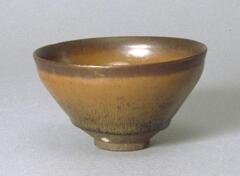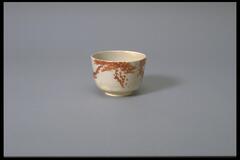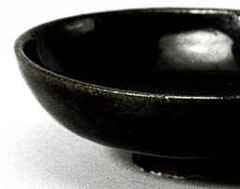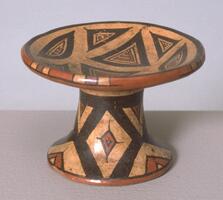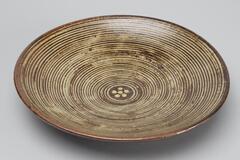72 Items in this Learning Collection
Collection Object
Collection Object
Collection Object
Collection Object
Collection Object
Collection Object
Collection Object
Collection Object
Collection Object
Collection Object
Collection Object
Collection Object
Collection Object
Collection Object
Collection Object
Collection Object
Collection Object
Collection Object
Collection Object
Collection Object
Collection Object
Collection Object
Collection Object
Collection Object
Collection Object
Collection Object
Collection Object
Collection Object
Collection Object
Collection Object
Collection Object
Collection Object
Collection Object
Collection Object
Collection Object
Collection Object
Collection Object
Collection Object
Collection Object
Collection Object
Resource with 15 media
Collection Object
Copyright
All Rights Reserved
()
Teabowl
Accession Number
2000/1.32
Title
Teabowl
Artist(s)
Chinese
Artist Nationality
Chinese (culture or style)
Object Creation Date
1179-1279
Medium & Support
stoneware with glaze
Dimensions
2 3/16 in x 4 11/16 in x 4 11/16 in (5.6 cm x 11.9 cm x 11.9 cm)
Credit Line
Gift of Stephen H. and Patricia O. Spurr from the Henry Jewett Greene Collection
Subject matter
This is a jian ware tea bowl - jianyao (建窑) or tian mu (天目) in China, tenmoku (天目) in Japan. It was made in the Song Dynasty (960 - 1279) in Shuijizhen, Jianyang, Fujian Province, China.
As early as the Tang dynasty (618-907), the area of today’s Fujian province was famous for its tea production. Naturally, the kilns in that region specialized in tea wares, both provincial and for the court. During the Song dynasty, a cluster of kilns known as the Jian kilns became famous for their sole production of dark iron-rich glazed stoneware teabowls. These bowls not only kept tea warm, but their dark glazes created an aesthetically pleasing contract against the thick milk-white whipped tea that was customary to drink during the Song.
A variety of controlled kiln “accidents” during the firing to temperatures up to 1,300 degrees Celsius, allowed for the crystallization of iron to create a variety of iridescent, spotted, and streaking effects, known as “oil spot,” “partridge-feather,” and most famous of all, “hare’s fur” glazes. Aesthete Song Emperor Huizong (r.1101-1125), in his Da guan cha lun (Essay on tea in the Da Guan reign, 1107-1110) expressed this about the humble black bowls, “For green and black teacups are highly valued, and those with streaks like hare’s fur most of all.” Furthermore, the Ching-te-Cchen T’ao Lu, written in 1795 by Lan Pu (trans. by Sayer), expresses, “In the Sung Days they preferred open-mouthed bowls for tea and considered the hare’s fur cups of Chien-an as the best.” (pg. 64) These precious, yet humble teabowls were not just favored by the court, but by scholars and Chan (Zen) monks as well.
The literary records of hare’s fur and Jian teabowls in China and Japan are extensive. Literati culture flourished during the Song dynasty; to be a gentleman one must not only be well read in the classics, but also be a connoiseur of fine arts, and engage in cultural pursuits such as poetry, music, tea and wine drinking. Renowned Northern Song literatus Su Shi mentions the pleasure of using Jian teabowls, “Surprised, I suddenly saw the hare’s-fur markings (tumao ban) on my teabowl; I ladled fine wine from my spring jar” (Mowry, p. 30). Likewise, the Song dynasty scholar-official, Cai Xiang, in his treatise on tea or Chalu, written on imperial command between 1049-1053, expresses both the practical and aesthetic merits of Jian teabowls from Fujian, and exclaiming they are the best:
"Tea is white, so black bowls are best. Tea bowls made in Fujian are deep; in color, they are bluish black with hare’s fur markings. Such bowls are thick-bodied; once warmed they retain their heat, so the tea does not cool too quickly. Tea bowls from other regions are either too thin or too purplish brown, so they are not as good as those from Fujian." (Mowry, p. 30).
During the sixth century, the Indian Monk Boddhidharma introduced the merits of drinking tea while meditating to Chinese Buddhists. Chan (Zen) Buddhists of the Song dynasty, whose monasteries were numerous around Fujian, used whipped tea in ceremonies where tea was passed hand to hand between practitioners, also recognized the practical and aesthetic value of Jian teabowls. In 1223, Japanese Zen priest Dogon, along with Kato Shiro and Saemon Kagemasa, visited the monastery on Mount Tianmu (Temmoku in Japanese), in Zhejian province, where Jian teabowls were in common use. Enamored, they traveled to Fujian to learn how to produce these teabowls. When they returned to Japan, they set up a kiln at Seto, to produce a similar product, which they called temmoku. Nevertheless, the original teabowls from Jian were valued over the local production, and Song dynasty Jian teabowls were imported into Japan at great quantities beginning in the 13th century and lasting at least through the 16th century, as prized antiques to be used in Japanese tea-ceremonies.
Physical Description
This deep, conical bowl on a straight foot ring is covered in a thickly applied dark, iron-rich black glaze with lighter, russet-brown hare's fur (兔毫盏, tuhao zhan) markings. The thick glaze thins at the rim to a russet-brown color.
Primary Object Classification
Ceramic
Primary Object Type
tea bowl
Collection Area
Asian
Rights
If you are interested in using an image for a publication, please visit http://umma.umich.edu/request-image for more information and to fill out the online Image Rights and Reproductions Request Form. Keywords
bowl
chawan
stoneware (pottery)
temmoku
2000/1.32
Title
Teabowl
Artist(s)
Chinese
Artist Nationality
Chinese (culture or style)
Object Creation Date
1179-1279
Medium & Support
stoneware with glaze
Dimensions
2 3/16 in x 4 11/16 in x 4 11/16 in (5.6 cm x 11.9 cm x 11.9 cm)
Credit Line
Gift of Stephen H. and Patricia O. Spurr from the Henry Jewett Greene Collection
Subject matter
This is a jian ware tea bowl - jianyao (建窑) or tian mu (天目) in China, tenmoku (天目) in Japan. It was made in the Song Dynasty (960 - 1279) in Shuijizhen, Jianyang, Fujian Province, China.
As early as the Tang dynasty (618-907), the area of today’s Fujian province was famous for its tea production. Naturally, the kilns in that region specialized in tea wares, both provincial and for the court. During the Song dynasty, a cluster of kilns known as the Jian kilns became famous for their sole production of dark iron-rich glazed stoneware teabowls. These bowls not only kept tea warm, but their dark glazes created an aesthetically pleasing contract against the thick milk-white whipped tea that was customary to drink during the Song.
A variety of controlled kiln “accidents” during the firing to temperatures up to 1,300 degrees Celsius, allowed for the crystallization of iron to create a variety of iridescent, spotted, and streaking effects, known as “oil spot,” “partridge-feather,” and most famous of all, “hare’s fur” glazes. Aesthete Song Emperor Huizong (r.1101-1125), in his Da guan cha lun (Essay on tea in the Da Guan reign, 1107-1110) expressed this about the humble black bowls, “For green and black teacups are highly valued, and those with streaks like hare’s fur most of all.” Furthermore, the Ching-te-Cchen T’ao Lu, written in 1795 by Lan Pu (trans. by Sayer), expresses, “In the Sung Days they preferred open-mouthed bowls for tea and considered the hare’s fur cups of Chien-an as the best.” (pg. 64) These precious, yet humble teabowls were not just favored by the court, but by scholars and Chan (Zen) monks as well.
The literary records of hare’s fur and Jian teabowls in China and Japan are extensive. Literati culture flourished during the Song dynasty; to be a gentleman one must not only be well read in the classics, but also be a connoiseur of fine arts, and engage in cultural pursuits such as poetry, music, tea and wine drinking. Renowned Northern Song literatus Su Shi mentions the pleasure of using Jian teabowls, “Surprised, I suddenly saw the hare’s-fur markings (tumao ban) on my teabowl; I ladled fine wine from my spring jar” (Mowry, p. 30). Likewise, the Song dynasty scholar-official, Cai Xiang, in his treatise on tea or Chalu, written on imperial command between 1049-1053, expresses both the practical and aesthetic merits of Jian teabowls from Fujian, and exclaiming they are the best:
"Tea is white, so black bowls are best. Tea bowls made in Fujian are deep; in color, they are bluish black with hare’s fur markings. Such bowls are thick-bodied; once warmed they retain their heat, so the tea does not cool too quickly. Tea bowls from other regions are either too thin or too purplish brown, so they are not as good as those from Fujian." (Mowry, p. 30).
During the sixth century, the Indian Monk Boddhidharma introduced the merits of drinking tea while meditating to Chinese Buddhists. Chan (Zen) Buddhists of the Song dynasty, whose monasteries were numerous around Fujian, used whipped tea in ceremonies where tea was passed hand to hand between practitioners, also recognized the practical and aesthetic value of Jian teabowls. In 1223, Japanese Zen priest Dogon, along with Kato Shiro and Saemon Kagemasa, visited the monastery on Mount Tianmu (Temmoku in Japanese), in Zhejian province, where Jian teabowls were in common use. Enamored, they traveled to Fujian to learn how to produce these teabowls. When they returned to Japan, they set up a kiln at Seto, to produce a similar product, which they called temmoku. Nevertheless, the original teabowls from Jian were valued over the local production, and Song dynasty Jian teabowls were imported into Japan at great quantities beginning in the 13th century and lasting at least through the 16th century, as prized antiques to be used in Japanese tea-ceremonies.
Physical Description
This deep, conical bowl on a straight foot ring is covered in a thickly applied dark, iron-rich black glaze with lighter, russet-brown hare's fur (兔毫盏, tuhao zhan) markings. The thick glaze thins at the rim to a russet-brown color.
Primary Object Classification
Ceramic
Primary Object Type
tea bowl
Collection Area
Asian
Rights
If you are interested in using an image for a publication, please visit http://umma.umich.edu/request-image for more information and to fill out the online Image Rights and Reproductions Request Form. Keywords
bowl
chawan
stoneware (pottery)
temmoku
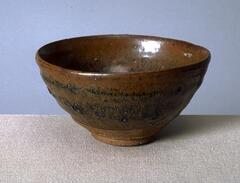
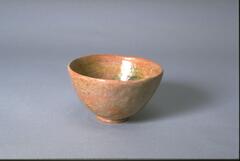
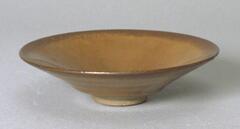
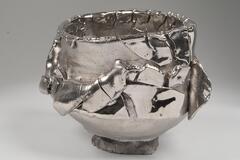
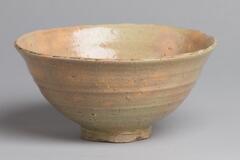
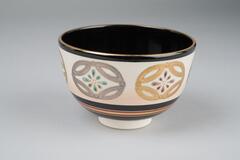
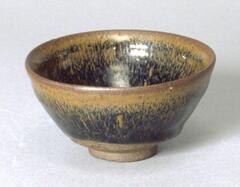
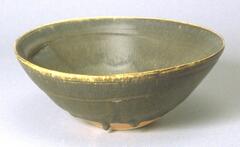

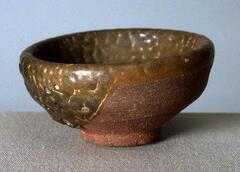
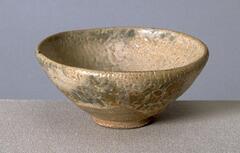
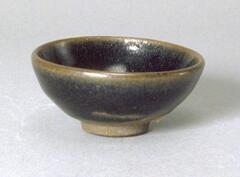
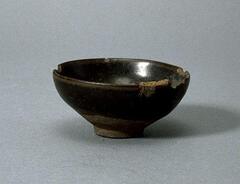
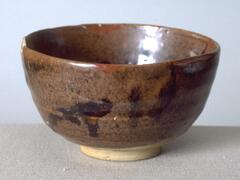
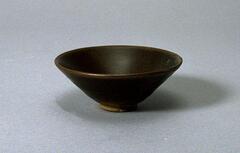
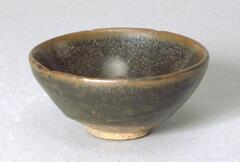

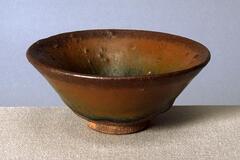
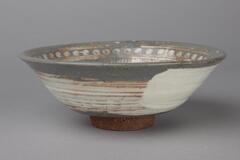
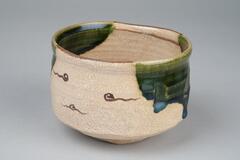
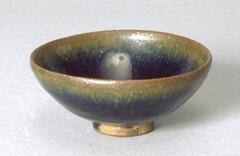


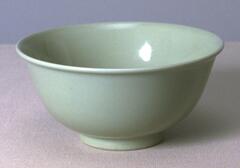

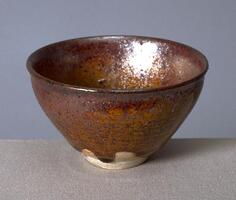
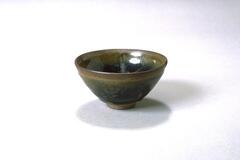

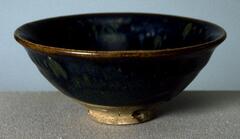
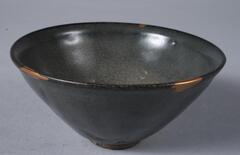
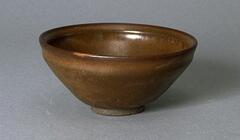
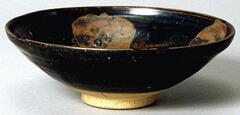
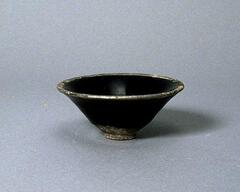
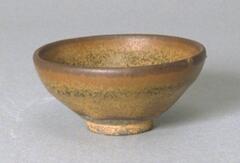
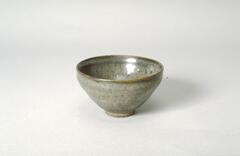

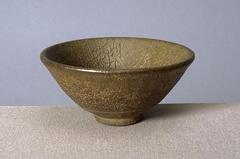
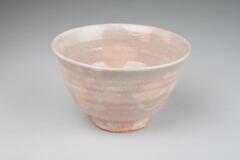
![Stoneware bowl with stamped rope-curtain design covered by a white slip and colorless glaze. A stylized inlaid chrysanthemum blossom decorates the center of the bowl, surrounded by a band of petals.<br />
<br />
This buncheong bowl with stamped design was maily supplied to government offices in the 15th century. It is decorated with a lotus flower on the inner base surrounded by lotus petals, butterflies and rows of dots on the inner wall. The outer wall, too, is filled with rows of dots. It was poorly sintered and the glaze applied to the lower part of the body is not melted in parts. The foot is not glazed and exposes the clay body.<br />
[Korean Collection, University of Michigan Museum of Art (2014) p.147] Stoneware bowl with stamped rope-curtain design covered by a white slip and colorless glaze. A stylized inlaid chrysanthemum blossom decorates the center of the bowl, surrounded by a band of petals.<br />
<br />
This buncheong bowl with stamped design was maily supplied to government offices in the 15th century. It is decorated with a lotus flower on the inner base surrounded by lotus petals, butterflies and rows of dots on the inner wall. The outer wall, too, is filled with rows of dots. It was poorly sintered and the glaze applied to the lower part of the body is not melted in parts. The foot is not glazed and exposes the clay body.<br />
[Korean Collection, University of Michigan Museum of Art (2014) p.147]](/media/W1siZiIsIjIwMjIvMDkvMjQvOWRtNDIyZTcyX2RlZmF1bHQuanBnIl0sWyJwIiwidGh1bWIiLCIyNDB4MjAwIl1d?sha=0b90e10dcc5f13d1)

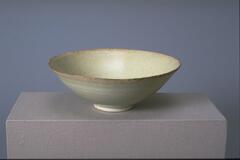
![<p>This is an undecorated bowl with diagonally flaring out sides. On the outer base and rim of the foot remain traces of refractory spur marks. The bowl was oxidized in the kiln, producing a green-brown hue, while the interior contains large bubbles. The color of its glaze is similar to that of other vessels excavated from sedimentary layers of refuse pile at celadon kilns in Goyang-si, Gyeonggi-do.<br />
[<em>Korean Collection, University of Michigan Museum of Art </em>(2014) p.101]</p>
<br />
It has an outwardly flared rim and steep side. A yellow brownish glaze is applied. The clay contains some impurities and the foot is relatively high. There is four spur-marks on the interior. <p>This is an undecorated bowl with diagonally flaring out sides. On the outer base and rim of the foot remain traces of refractory spur marks. The bowl was oxidized in the kiln, producing a green-brown hue, while the interior contains large bubbles. The color of its glaze is similar to that of other vessels excavated from sedimentary layers of refuse pile at celadon kilns in Goyang-si, Gyeonggi-do.<br />
[<em>Korean Collection, University of Michigan Museum of Art </em>(2014) p.101]</p>
<br />
It has an outwardly flared rim and steep side. A yellow brownish glaze is applied. The clay contains some impurities and the foot is relatively high. There is four spur-marks on the interior.](/media/W1siZiIsIjIwMjIvMDUvMjUvMnhtbDducjBocl9kZWZhdWx0LmpwZyJdLFsicCIsInRodW1iIiwiMjQweDIwMCJdXQ?sha=ab0ce1dba1be4d21)
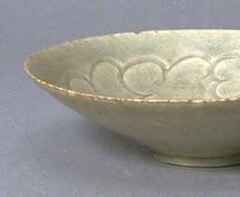
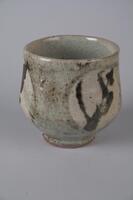
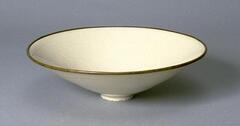
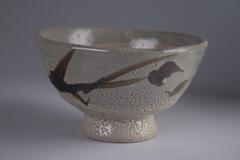
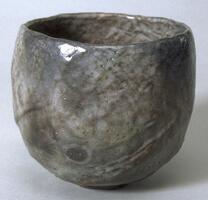

![Stoneware tea bowl with slightly flaring lip, white slip hakame design and colorless glaze.<br />
<br />
The inner and outer surfaces of this buncheong bowl have been brushed with white slip. Its inner base retains traces of seven spurs, while the uneven application of glaze has exposed the unglazed body. The glaze itself was fairly well fused. The bowl is intact without damage.<br />
[Korean Collection, University of Michigan Museum of Art (2014) p.156] Stoneware tea bowl with slightly flaring lip, white slip hakame design and colorless glaze.<br />
<br />
The inner and outer surfaces of this buncheong bowl have been brushed with white slip. Its inner base retains traces of seven spurs, while the uneven application of glaze has exposed the unglazed body. The glaze itself was fairly well fused. The bowl is intact without damage.<br />
[Korean Collection, University of Michigan Museum of Art (2014) p.156]](/media/W1siZiIsIjIwMjIvMDkvMjQvNm9xY20waHdlX2RlZmF1bHQuanBnIl0sWyJwIiwidGh1bWIiLCIyNDB4MjAwIl1d?sha=36b91ee5facf512c)
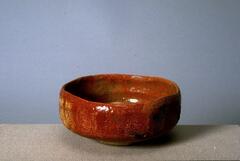
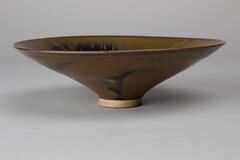
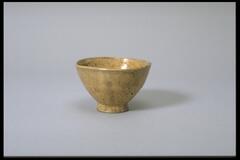
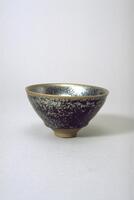

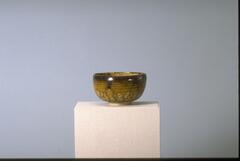
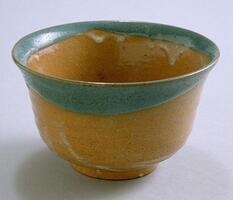




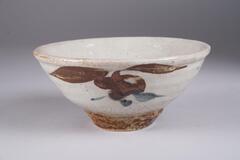
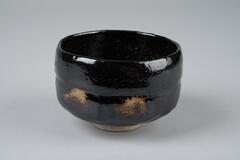
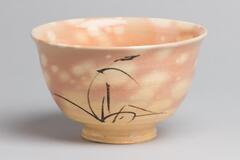

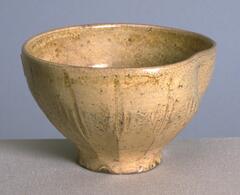
![<p>This bowl exemplifies early-tenth century celadon forms influenced by Chinese Yue ware. It has a halo-shaped foot (haemurigup), a characteristic of Yue ware. It is a high-quality celadon made from fine clay, coated by highly transparent glaze. Surface is plain while displaying crackles on its inner surface and parts of its outer surface. Many similar vessels were excavated from the Kilns no. 9 and no. 10 at Yongun-ri, Gangjin-gun, Jeollanam-do. Refractory spur marks created during firing remain in five places on the rim of the foot.<br />
[<i>Korean Collection, University of Michigan Museum of Art </i>(2014) p.88]</p>
Stoneware tea bowl with celadon glaze. <p>This bowl exemplifies early-tenth century celadon forms influenced by Chinese Yue ware. It has a halo-shaped foot (haemurigup), a characteristic of Yue ware. It is a high-quality celadon made from fine clay, coated by highly transparent glaze. Surface is plain while displaying crackles on its inner surface and parts of its outer surface. Many similar vessels were excavated from the Kilns no. 9 and no. 10 at Yongun-ri, Gangjin-gun, Jeollanam-do. Refractory spur marks created during firing remain in five places on the rim of the foot.<br />
[<i>Korean Collection, University of Michigan Museum of Art </i>(2014) p.88]</p>
Stoneware tea bowl with celadon glaze.](/media/W1siZiIsIjIwMjIvMDkvMjQvMXB2aXlzcnZpZF9kZWZhdWx0LmpwZyJdLFsicCIsInRodW1iIiwiMjQweDIwMCJdXQ?sha=7ddc9c1585910d07)

